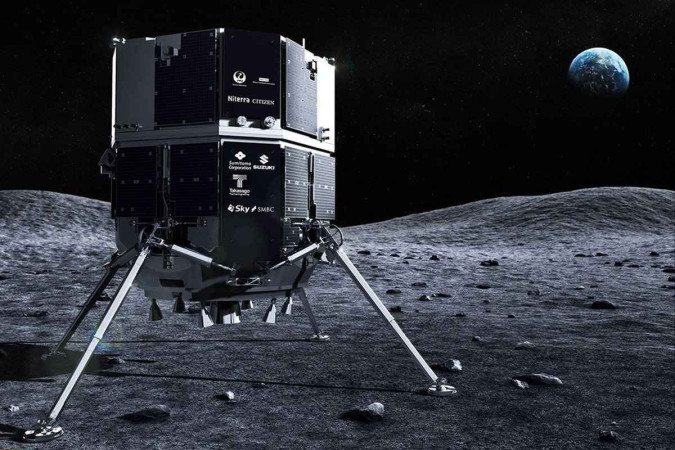A Japanese probe disappears from radar when trying to land on the Moon; See the latest photos
3 min read
Posted: 4/25/2023 4:48 PM / Updated 4/25/2023 4:51 PM

Illustrative image of how the probe landed on the Moon, which ultimately didn’t happen – (Credit: Reproduction/Ispace)
After four months of traveling between Earth and lunar orbit, the Japanese space probe Hakuto-R apparently failed to land on the lunar surface, the target of the spacecraft built by the company ispace. With a landing scheduled for 1:40 p.m. (Brasilia time) this Tuesday (4/25), the probe has stopped sending a signal to the Mission Control team as it attempts to reach the floor of Atlas crater, in the Mare Frigores (cold. sea), on The satellite.
“At the moment, the mission control center in Tokyo has not been able to confirm the success of the probe. We have to assume that we were unable to complete the moon landing,” said Takeshi Hakamada, founder and CEO of ispace. During the company’s promoted live broadcast of the landing.
Takeshi also stated that the company will continue to attempt to contact the probe to determine what happened between the landing maneuvers and the landing itself. Despite the rhetoric, it still cannot be said that the landing really failed – the team will continue to make other attempts. Before ceasing to transmit signals, Hakuto-R returned the last images, of the lunar soil. look:
If it lands on the moon in a smooth and controlled manner, the Hakuto-R will be the first Japanese aircraft and the first by a private company to explore Earth’s natural satellite. However, in case of failure, the moon will continue to get to the explorers only the United States, the Soviet Union and China – the countries that sent robots that successfully completed the task of monitoring the lunar soil.
Hakuto-R was launched into space in December 2022, via a SpaceX Falcon 9 rocket. It was carrying two explorer robots: Sora-Q, developed by the Japan Aerospace Exploration Agency, and Rashid, a larger 10-kilogram explorer, which will be operated by the UAE Space Agency.
The spacecraft circled the moon several times before reaching lunar orbit on March 20 this year. The landing, scheduled for today, consisted of a series of maneuvers that took about an hour to complete – from orbit to lunar soil about 100 kilometers.
Upon reaching the Atlas Crater, in the Mare Frigoris area, the body appeared to be in a good position, with the ‘feet’ pointed well into the ground, maintaining a smooth landing, essential to the machine’s survival. However, upon arriving at the appointed time for landing, Hakuto-R did not send a signal to the control center.
10 years of working for nothing? The mission is considered successful
Although almost certain to fail, ispace does not consider the task to be a failure. For scientists, getting to the moment of landing is as satisfying as a first attempt to reach the moon. “We are very proud. We have already accomplished many things during this Mission 1,” said Takeshi Hakamada.
The creation of Hakuto-R began in 2013, when the company entered Google’s competition, the Google Luna X Prize, designed to encourage companies to land a private robotic probe on the moon for the first time – the financial contribution amounted to 20 million US dollars.
Although there was no winner – the award was valid until 2018 – ispace continued to develop the spacecraft. Now, the company intends to launch its second and third satellite landing missions in 2024 and 2025, respectively.
mobile news
Receive the latest news published by Brazilian Post. It’s free. Click here and join the community mailone of the innovations launched by WhatsApp.
Give your opinion
a mail There is space in the print edition to post readers’ opinions. Letters must contain a maximum of 10 lines and include the name, address and telephone number of the email [email protected].

“Musicaholic. Thinker. Extreme travel trailblazer. Communicator. Total creator. Twitter enthusiast.”







